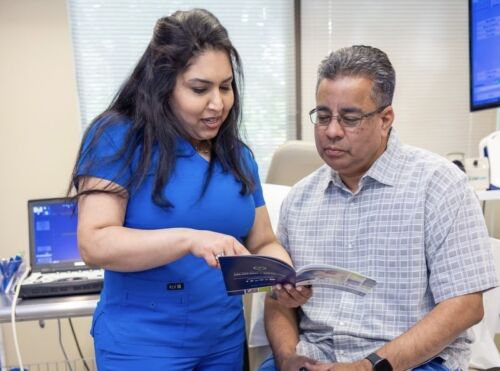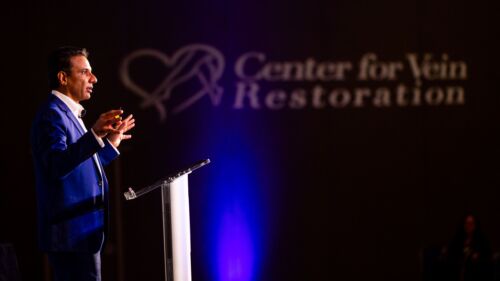Swollen veins are the most common sign of vein disease. But did you know the condition also causes skin damage?
Varicose veins cause many uncomfortable symptoms. Pain, itching, swelling, and a feeling of heaviness in the leg are all characteristics of a vein condition called venous insufficiency. These symptoms could indicate that the tiny valves in your leg veins aren't moving blood up to your heart as they should. As a result, blood pools in your leg. In addition, vein disease also leads to skin damage, another prominent symptom that is often overlooked.
Unfortunately, skin damage caused by venous insufficiency may be initially dismissed as a dermatological problem. Most people assume the bruise or discoloration on their leg or foot will eventually heal. But when the skin continues to darken or thicken, it may be time for a vein specialist to check the veins to understand the true source of the damage — vein disease.
How does vein disease cause skin damage?
Skin damage caused by venous insufficiency is known as venous stasis dermatitis or venous eczema. When blood is trapped in the veins, the vein swells as fluid leaks into the surrounding tissue. The excess fluid also affects your skin, mainly because the fluid buildup prevents nourishing oxygenated blood from reaching the skin. Without oxygen, your skin cannot properly heal.
The first sign of skin damage is the appearance of orange- or brown-colored spots, also called cayenne pepper shots, on the lower legs and feet. This discoloration results from blood pressure building in the vein, causing the tiny capillaries to burst, turning the skin red or brown. From there, the skin damage advances to other changes, such as the following:
Hyperpigmentation. When red blood cells in the vein break down, the iron in the blood seeps into the skin, changing it to a deep purple or unsightly brownish hue. It’s easy to mistake this for a bruise. But when it doesn’t fade as most bruises do, the bruise may be a sign of vein disease.
Lipodermatosclerosis. The skin takes on a rough, thick, or leathery texture.
Corona Phlebectasia. Blocked blood flow in the veins in the feet and ankles turn the skin into a dark blue color.
Skin ulcers. This is the most severe complication of venous dermatitis. At this point, the damage has progressed to open sores that may ooze blood and pus. Treatment is necessary to heal the wound.
Healing your skin
If you are one of the 23 percent of adults with varicose veins, you have a higher risk of venous eczema. But it’s important to remember that skin changes related to vein disease may not always occur along with varicose veins. The diseased vein may be deeper within the leg and not visible. Nevertheless, the trapped blood and fluid accumulation may lead to blemished skin.
Treating your varicose veins can slow the progression of venous insufficiency and prevent skin damage. Today’s minimally invasive varicose vein treatments destroy the diseased vein so blood can flow to nearby healthier veins. Circulation is restored, and the diseased vein disappears over time.
Therapy for open wounds involves prescribing antibiotics to prevent an infection. Your doctor may also recommend wearing an Unna boot or a medicated wrap placed around the ulcer. The boot compresses the veins to encourage blood flow and prevent pooling. It also contains a zinc oxide gel to speed the healing process.
Venous skin ulcers can be difficult to treat and heal, making it vital to get treatment for varicose veins or any sign of venous insufficiency before it reaches that stage. Healing your veins is beneficial for your circulation and your skin, too!
Vein treatment at CVR’s Texas offices
Center for Vein Restoration (CVR) operates two facilities in Austin, Texas. Both offices are led by Aditya Gupta, MD, RPVI, DABVLM, an experienced vein physician who holds board certification in Internal Medicine and Venous and Lymphatic Medicine.
Dr. Gupta uses his years of experience and knowledge to develop individualized treatment plans. To schedule a consultation with Dr. Gupta, visit www.centerforvein.com, or call 240-965-3915 to speak to a representative.
11111 Research Boulevard
Suite 400
Austin, Texas 78759
7900 Farm to Market Road 1826
Building 1, Suite 170
Austin, TX 78737

 About Vein Disease
About Vein Disease
 Spider Veins
Spider Veins
 Varicose Veins
Varicose Veins
 Vein Disease Treatments
Vein Disease Treatments
 Treating Spider Veins
Treating Spider Veins
 Treating Varicose Veins
Treating Varicose Veins
 About Us
About Us
 Patient Resources
Patient Resources
 Physician Resources
Physician Resources


